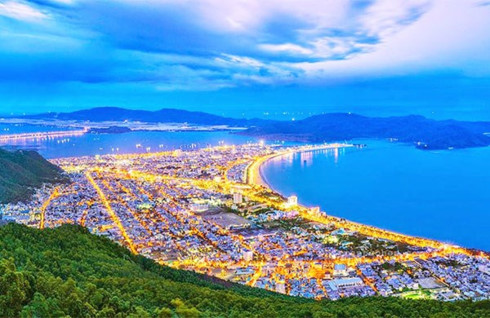



Prior to 2015, the tourism industry in Binh Dinh was still
nascent. Most tourists coming to the central region of Vietnam opted for
‘established’ spots like Khanh Hoa province or the region’s economic centre
city of Da Nang.
But over time, with political commitment and
measures to promote investment in tourism, the ‘tourist paradise’ of Binh Dinh
has finally ‘awakened’ after years of slumber.
In 2016, Binh Dinh received some 3.2 million tourists including
265,000 foreign arrivals, up 23% over 2015, earning total revenue of VND1.45
trillion (US$63.8 million). In the province’s tourism master plan, by 2020, the
province will try to achieve 5.5 million arrivals.
Contrary to the majority of tourist destinations
in Vietnam which have suffered from overdevelopment, many of the landscapes in
the central province for now remain untouched and still retain their natural
characteristics – translating to a huge draw for tourists.
Visitors to Binh Dinh mostly seek to enjoy the peacefulness, the
majestic landscapes and a diverse culinary experience at a reasonable cost.
Not far from the province’s capital city of Quy Nhon, some of
the locations that have gained popularity amongst the young Vietnamese are Ky
Co beach – considered the Maldives of Vietnam – Trung Luong beach, Hon Kho or
Cu Lao Xanh isles, among others.
Cu Lao Xanh isle, roughly translated to Green Island, lives up
to its name as the natural verdant forest covering the island remains mostly
intact, save for the settlement area home to a local population of less than
2,000 people.
Its tourism industry is still mostly small-scale
household-based. But according to Phan Van Binh, vice chairman of Nhon Chau
People's Commune, the situation has seen some development.
"In recent years, tourists from HCM City, Hanoi, even Central
Highlands, have started to notice the isle. So far this year, the isle welcomed
some 1,500 tourists,” he said.
The authorities are urging local residents to adopt the homestay
model, by borrowing loans to renovate their houses.
"In addition, we also are calling for investment so tourists may
enjoy diverse forms of tourism, as well as creating jobs for locals,” Binh
added.
Aside from natural charm, Binh Dinh is also a land of rich
culture and history as the province is simultaneously the centre of Buddhism in
the central region as well as one of the main areas of the ancient Champa
kingdom, whose presence can still be felt by the numerous Cham towers standing
today.
Historical researchers say the Cham towers in the province, some
as old as a thousand years, are the largest in all of Southeast Asia.
Despite the province’s advantages, the quick growth of tourist
arrivals is posing a number of problems for local authorities.
This year, right when the tourism season began, most hotels and
lodgings (3-star and above) in Quy Nhon City had run out of vacancies.
Nguyen Thi Thu Giang, a tourist from Hanoi, said, her company
with 40 people called for reservations a month ago but most known hotels were
already full, and "the company had to book rooms in a 2-star hotel whose
services leave much to be desired.”
Another downside of the tourism industry here is the lack of
diverse forms of entertainment. During daytime, tourists can choose to go on
island-sea journeys, or visit museums or historical sites, but come night,
there’s not many activities.
Tourists frequently complain that most restaurants and coffee
shops here close up shop quite early, while they’d like to wander around the
city until late at night.
Duong Tien Dong, another tourist from Hanoi, said that during
the three nights he and his family stayed in Quy Nhon, they "could only go to
the beach and drink coconut juice, since there’s nothing else to do.”
Infrastructure also still leaves much room for improvement. The
entire length of Quy Nhon beach only features a handful of public toilets, and
they are severely run-down.
In addition, unlike in Da Nang city, there is a total lack of
public showers. After swimming in the sea, tourists have to come all the way
back to their hotels for showers. The absence of signboards or location guides
also causes difficulties for tourists in finding their way around.
Duong Trung Quoc, a noted historian and also a National Assembly
deputy, has said Binh Dinh must create "touristically viable” products
combining its natural landscapes of seas and islands with culture and history.
Quoc also suggested Binh Dinh "connect” with other localities in
the region that share similar culture and heritages, for example, with Da Nang
and Ninh Thuan province in promoting ancient Champa culture.
Regarding the recently emerged issues of vendors soliciting or
overcharging tourists, Huynh Cao Nhat, deputy head of the provincial tourism
department, said "it’s important to build a community who knows how to do
tourism.”
That means everyone from the people, to businesses, and
authorities of all levels must "exercise professional conducts in receiving
tourists.” The department also said it would heavily sanction those who do
wrong, "negatively impacting the province’s tourism.”
The province is building a "science complex,” complete with
science museums and a planetarium, with the intention of bringing a new flavour
of tourism.
Homestay tourism and traditional sports and cultural activities
will also be the focus in the future.
In order for all these attractions to maximise their use,
Chairman of the provincial People's Committee Ho Quoc Dung said the authorities
are trying to complete numerous infrastructure projects, including the airport
Phu Cat, expanding and upgrading roads – especially ones connecting popular
attractions—and building quality public showers and toilets along the Quy Nhon
beach.
The budding tourism in
Binh Dinh is a good indication for the locality’s economy, but if management
and proper oversight in the long term is not done, a plethora of problems could
derail the development of this ‘smokeless industry.
Source: VOV